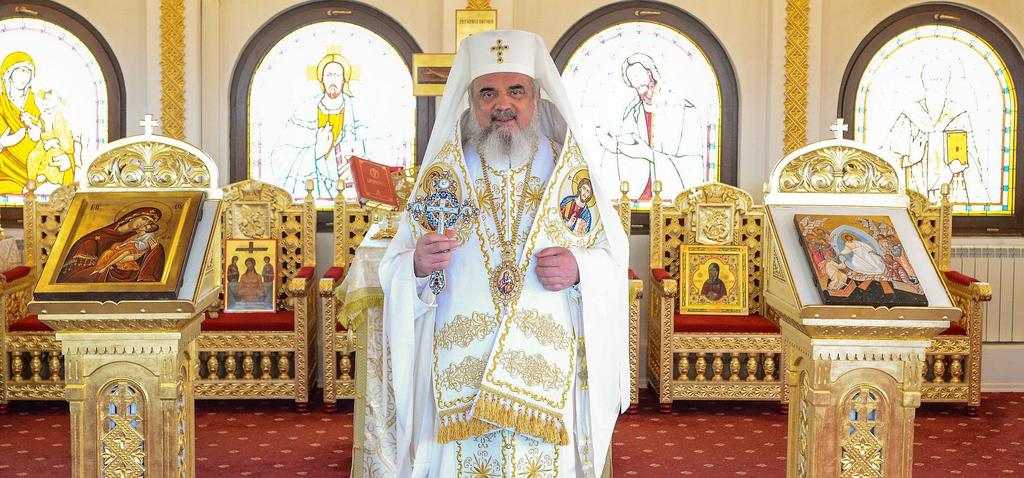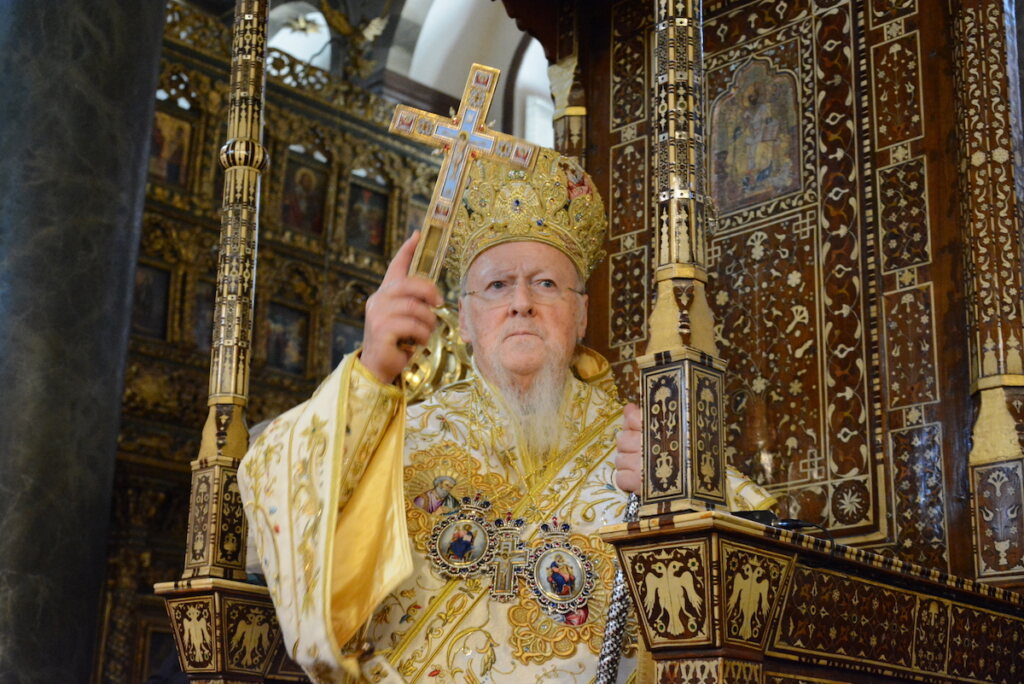Today, 2 August 2015, the 9th Sunday after Pentecost, the Orthodox Church reads, at the Divine Liturgy, the evangelical parable of Saint Matthew 14:22-34 which presents Jesus walking on water and Calming the storm: “Immediately Jesus made the disciples get into the boat and go on ahead of him to the other side, while he dismissed the crowd. After he had dismissed them, he went up on a mountainside by himself to pray. Later that night, he was there alone, and the boat was already a considerable distance from land, buffeted by the waves because the wind was against it. Shortly before dawn Jesus went out to them, walking on the lake. When the disciples saw him walking on the lake, they were terrified. “It’s a ghost,” they said, and cried out in fear. But Jesus immediately said to them: “Take courage! It is I. Don’t be afraid.” “Lord, if it’s you,” Peter replied, “tell me to come to you on the water.” “Come,” he said. Then Peter got down out of the boat, walked on the water and came toward Jesus. But when he saw the wind, he was afraid and, beginning to sink, cried out, “Lord, save me!” Immediately Jesus reached out his hand and caught him. “You of little faith,” he said, “why did you doubt?” And when they climbed into the boat, the wind died down. Then those who were in the boat worshiped him, saying, “Truly you are the Son of God.” When they had crossed over, they landed at Gennesaret.”
Any good deed must be ascribed to God
His Beatitude Daniel, Patriarch of the Romanian Orthodox Church delivered the sermon during the Divine Liturgy celebrated in the chapel of the Patriarchal Residence dedicated to “Saint Gregory the Enlightener”, and explained the teaching of this evangelical parable: “The Gospel shows us, first of all, that after He miraculously fed thousands of people with only five loaves and two fish, Christ retired in the mountains, in loneliness, to pray. Why does He pray after making that wonder? It is to teach us to thank God for any achievement or victory in our life. Why does He pray in loneliness? It was because He did not want the crowds whom He fed multiplying the loaves and fish to praise Him, as well as to focus on His prayer to God-the-Father. When Jesus prays to the Father from heaven in loneliness, His heart is full of the gift of the merciful love of the heavenly Father which He shares afterwards to the humans. Thus, the Gospel shows us that any good deed must be ascribed to God. Thus, we learn that after a great success or achievement we must not wish the appreciation of the people, but the peace and quiet of our hearts detached from the glory coming from the people, and glorify God for the help received from Him, and pray Him to fill our souls not to have empty souls while living among humans.
“When He retires to the mountains to pray, Jesus Christ, our Lord, teaches us that the mountain is a place of union of the earth with heaven, a place of spiritual elevation, because it urges us to look for God-the-Creator, the One who is higher than the beauty and greatness He created. This is why the church, the place of worship is built on a hill or on a higher place which calls us to spiritual climbing, to ascension from the worries of the earth and aspiration to the heavenly life”, His Beatitude also showed.
Then, the Patriarch of Romania emphasised the fact why Jesus Christ, our Saviour, urged His disciples to cross the sea before Him: “Before climbing the mountain to pray, He told the disciples to get into the ship and cross to the other shore till He dismisses the crowds. Namely, He insistingly urged them to cross the sea. Why did Christ, our Lord, send them to cross the sea while He was climbing the mountain? Because the spiritual Teacher of the disciples wanted them to fight for themselves, not only to get everything ready, with no effort whatsoever. He wanted to teach the disciples to pass through trials, temptations, or hard situations in order to better understand how great the divine blessing and help is in their lives.”
His Beatitude Patriarch Daniel explained the significance of Jesus Christ’s walking on the sea: “The Gospel tells us that, between the third hour after midnight and sunrise, Jesus was walking on the sea to the ship of the disciples which was in danger because of the big waves caused by the storm. This coming of Jesus to His disciples at that time of the night, when the darkness of the night was to be overcome by the light of the day, shows us that He chose the respective time as a symbol of the spiritual fight. Why was Jesus going to them walking on the sea just like on the land? It was because He wanted to show them that He was reigning over the waters just like over the lands, because He had made the earth, sea and land. He walks on the sea just like on the land when He wants to, because He is higher than all the storms of the world. He is not submitted to the laws of the matter, weight, opacity, rigidness, liquidness, or to their limits”.
Firm faith in Jesus Christ defeats the difficulty of trials
His Beatitude Daniel spoke about the desire of Saint Peter to walk on the water to meet Lord Jesus, a wish stemmed from his devoted faith: “First, the disciples terrified because of the rough sea at night time did not recognise Him and cried out in fear thinking that a ghost was coming to them. So, their fear not to sink in the sea because of the storm was increased by the fear of an unknown power. But while walking on the sea and coming to them, Jesus told them: Take courage! It is I. Don’t be afraid. When His disciples recognised His voice, without clearly seeing His face, Saint Peter said: Lord, if it’s you, tell me to come to you on the water”. Saint Peter confesses in these words that Jesus is Lord or Master over the forces of nature and thinks that he can walk on the water if Jesus commands him to, just like Jesus. This is why, the Lord told Peter: Come! The desire of Saint Peter to walk on the sea to Jesus stems from his gratitude to Jesus and from his desire to meet Him. Why did Saint Peter want to get off the ship and walk on the water and why did Jesus allow this unusual fact and even dangerous? Had Saint Peter had only prudence, but not faith, he would not have got off the sip in the full swing of the storm and neither had the Lord told him Come! Therefore, it goes without saying that Saint Peter wanted to get off the ship and walk on the water not because of simple selfish curiosity, but because he wanted to show respect and gratitude to Jesus because He was coming to save His disciples. Yet, Saint Peter gets off the ship only with Jesus’ blessing. This is why he told Jesus: ‘Lord, if it’s you, tell me to come to you on the water’, showing his lowliness and obedience to Jesus Christ, the Lord, his and the other disciples’ Teacher. In fact, the Gospel shows us this truth: firm faith in Jesus Christ overcomes the difficulty of the trials.
“As long as Saint Peter was looking only at Jesus, he could walk on water just like Jesus. But when Saint Peter looked at the wind and was afraid he started to doubt and sink in the water. Therefore, Peter started sinking in the water only when his faith weakened as direct relation with Jesus, as spiritual relationship with His divine Person, superior to the earthly world or to the cosmic forces created by God. More exactly, the Gospel shows us that as long as our faith in Christ-the-Lord is firm and alive, we can be saved just because He helps us not to be enslaved by the forces of the material world, or despair in the storm of the trials of life.
We learn from the Gospel of the day that, in fact, the ship sailing on the rough sea is the symbol of the Church present in the world, His Beatitude Patriarch Daniel said, further saying:“The Gospel read today has some other spiritual meanings too, because it refers not only to Saint Peter and to the other disciples in the ship in danger to sink, but also, prophetically, to the entire Church and to every Christian. Understood as a symbol, the ship represents the Church tried by the waves or storms of history, persecutions, heresies, dark hostile forces. The wind hostile to the ship represents the times or situations in which the Church meets hostility and rejection in her missionary work to pass the people from the earthly temporary life to the heavenly eternal one. This Gospel also shows us how the Christian soul must fight at time of trial. Some of the Holy Fathers understood the ship battered by waves as the image of the faithful man in his fight both against the trials of the life and against the tremendous passions. But if Jesus Christ, our Saviour is called in prayer to help the man tormented by temptations and troubles, as he did with the ship of His disciples in danger and calmed down the storm, so will He calm the storm of the selfish passions, of troubles and of the sufferance that affects the human being.”






